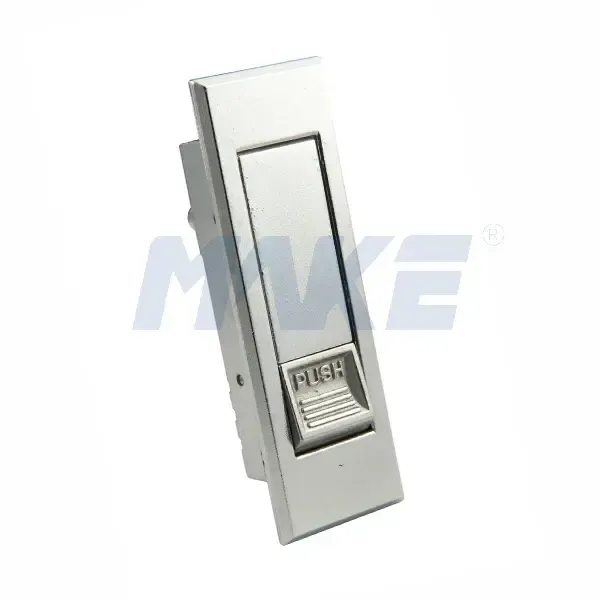In the modern world, where convenience and security go hand in hand, traditional keyed locks are gradually being replaced by smarter and more efficient locking systems. One such innovation transforming both residential and commercial security is the push button lock — a keyless entry system that allows access using a numeric code instead of a physical key.
Push button locks are rapidly gaining popularity because they provide a blend of flexibility, control, and user-friendly operation. These locks remove the risks associated with lost keys, make it easier to manage access for multiple users, and introduce advanced programmable features that were once only seen in high-end security systems.
From business facilities, schools, hospitals, and hotels to residential homes and rental properties, push button locks are becoming a preferred choice for property owners seeking both convenience and peace of mind. They represent a major step forward in access control — simple in operation, yet powerful in performance.

At its core, a push button lock operates on a numeric keypad. Instead of turning a key, users press a sequence of digits that correspond to a specific code. When entered correctly, the locking mechanism disengages, granting access.
These systems can be broadly classified into two main types: mechanical push button locks and electronic push button locks, each with its own advantages and applications.
Mechanical push button locks use a completely mechanical internal mechanism. They do not rely on batteries or electricity, making them an ideal choice for environments where power may not be available.
Each button corresponds to a part of a coded sequence. When the correct combination is pressed, mechanical pins or tumblers align, allowing the latch to open.
Advantages:
No battery or power required
Reliable even in harsh outdoor conditions
Simple installation and low maintenance
Mechanical locks are widely used for gates, storage rooms, lockers, or maintenance areas where reliability is essential, and power sources are limited.
Electronic push button locks take the concept further by incorporating electronic circuitry. The keypad sends a signal to a small motor or solenoid inside the lock when the correct code is entered, which releases the latch or bolt.
Modern electronic versions offer programmable features, such as:
Multiple user codes
Time-restricted access
Auto-locking after entry
Integration with alarms or smart home systems
They often include an LCD screen or backlit keypad for better visibility at night and can even connect to management software for remote configuration.
The newest generation of push button locks merges traditional code entry with RFID cards, Bluetooth, Wi-Fi, or biometric authentication. Users can choose between several entry methods — a numeric code, smartphone app, fingerprint, or proximity card — depending on their preference and security requirements.
These hybrid systems are especially common in corporate offices and commercial complexes, where varying access levels are required across different departments or facilities.
The popularity of push button locks is no coincidence. They combine practical convenience with enhanced security, offering significant advantages over traditional keyed locks and even some newer electronic systems.
The most obvious benefit is the elimination of physical keys. Losing a key not only causes inconvenience but also introduces serious security risks — from unauthorized duplication to expensive rekeying or lock replacement.
With push button locks, users simply need to remember a code. This saves time and costs associated with managing multiple keys, especially in environments like offices, schools, or shared accommodations.
Codes can be added, changed, or deleted within seconds, offering tremendous flexibility. Businesses can update access codes when employees leave or roles change, and homeowners can easily create temporary access for guests or service providers.
Some systems allow dozens — or even hundreds — of user codes, giving complete control over who can access which doors and when.
Push button locks make it easy to issue temporary codes for short-term access. For instance, cleaning crews, contractors, or guests can receive a code that expires automatically after a set time or date.
This feature is particularly valuable in hospitality and property rental sectors, where property managers or Airbnb hosts can grant access remotely without the need for physical key handovers.
In busy environments where people enter and exit frequently, push button locks provide quick, seamless access. Users can unlock doors in seconds, avoiding the delays and frustration often caused by misplaced keys or mechanical jamming.
Security is where push button locks truly shine. Many advanced models offer:
Anti-tamper protection: The system locks out after several incorrect code attempts.
Audit trails: Electronic locks can record entry logs, showing who accessed the door and when.
Dual authentication: Some models require both a code and an RFID card for high-security zones.
Automatic relocking: The door automatically locks after a specified time, ensuring the area remains secure.
These smart features make push button locks an excellent choice for sensitive facilities like data centers, healthcare institutions, and laboratories.
While the initial purchase and installation cost may be slightly higher than that of a traditional lock, push button locks reduce long-term expenses by eliminating the need for rekeying, key duplication, and frequent mechanical maintenance.
In large organizations with hundreds of users, this can lead to significant annual savings while improving overall security management.
Proper maintenance is essential for ensuring long-lasting performance, but one of the biggest strengths of push button locks is their durability. Designed to handle high traffic and daily use, they’re built from robust materials and engineered for longevity.
For electronic models, regular battery checks are key. Most locks run efficiently for one to two years on standard alkaline batteries, depending on usage frequency.
Modern locks include low-battery indicators, and some even allow external power backup or emergency override keys to prevent accidental lockouts.
High-quality push button locks are crafted from stainless steel, zinc alloy, or brass, providing excellent resistance to wear, impact, and corrosion. These materials ensure long-term operation even in demanding environments.
For outdoor use, many push button locks are designed with IP-rated enclosures to withstand rain, dust, and temperature variations. Weather-sealed keypads prevent moisture intrusion, ensuring smooth operation in both residential gates and industrial facilities.
A simple maintenance routine includes checking for loose screws, cleaning the keypad surface, and ensuring the latch mechanism moves freely. For mechanical models, a small amount of lubrication on moving parts can prevent jamming and ensure smooth operation.
Push button locks are incredibly versatile and can be tailored to fit a wide range of security applications. Their design flexibility makes them suitable for almost any environment requiring controlled access.
In office environments, where employee turnover and departmental access levels vary, push button locks simplify security management. Administrators can assign unique codes for departments or staff, update them as needed, and monitor entry logs in real time.
Factories, data centers, and storage facilities require reliable and durable locking systems. Mechanical push button locks are often chosen for industrial doors or gates due to their rugged design and zero power dependency. Meanwhile, electronic versions help supervisors maintain access logs and enforce restricted entry policies.
Schools and universities use push button locks to secure classrooms, laboratories, and administrative offices. Teachers and staff can be issued separate codes, and schedules can be programmed to restrict access after hours.
Hospitals, clinics, and pharmacies require controlled access to protect sensitive areas such as medicine storage or patient records. Push button locks provide the perfect solution, allowing for secure, hygienic, and convenient access without the need to handle shared keys.
For homeowners, push button locks offer a blend of style and safety. They provide effortless entry for family members and can be integrated with smart home systems for remote monitoring. Additionally, temporary codes can be issued to cleaners, delivery personnel, or guests.
Hotels, resorts, and short-term rentals benefit greatly from push button locks. Property managers can remotely generate and send codes to guests, eliminating check-in delays and improving operational efficiency. After checkout, the code automatically expires, maintaining property security.
Government buildings and military facilities rely on the dependability of push button locks for restricted zones. Some models incorporate encryption and dual-factor authentication to meet strict security standards.
Installing a push button lock is a relatively straightforward process, and many models are designed to fit standard door preps, making them compatible with existing doors and frames.
The general steps include:
Removing the old hardware and confirming door compatibility.
Installing the new latch assembly and securing the keypad or knob.
Connecting power or inserting batteries (for electronic models).
Programming access codes through the keypad or associated mobile application.
For businesses managing multiple locks, centralized control platforms are available. These allow remote configuration, code assignment, and real-time monitoring of multiple entry points simultaneously — an essential feature for large facilities.
|
Feature |
Push Button Lock |
Traditional Key Lock |
Smart Lock (Wi-Fi/Bluetooth) |
|
Keyless Operation |
√ |
× |
√ |
|
Power Requirement |
Optional |
× |
√ |
|
Programmable Access Codes |
√ |
× |
√ |
|
Remote Access |
Limited |
× |
√ |
|
Cost Efficiency |
High |
Moderate |
Moderate |
|
Security Level |
High |
Medium |
High |
|
Maintenance |
Low |
Medium |
Moderate |
Push button locks occupy a middle ground between traditional and fully digital locks. They provide most of the benefits of smart locks — such as code-based access and flexibility — without requiring constant network connectivity, making them more reliable for many practical applications.
As part of the broader smart access revolution, push button locks are evolving rapidly. Several exciting innovations are shaping the next generation of these systems:
Many modern push button locks now integrate with smart home systems like Google Home, Alexa, and Apple HomeKit. Users can lock or unlock doors through voice commands or automation routines.
Wireless models connect to smartphones via Bluetooth or Wi-Fi, allowing administrators to program codes, check logs, and control locks remotely.
To prevent hacking or signal interception, manufacturers are implementing AES-128 or AES-256 encryption, ensuring that transmitted data remains secure.
Some high-end models combine keypads with biometric sensors, RFID cards, or mobile credentials — offering multiple layers of verification for sensitive environments.
Next-generation locks are being designed with low-power consumption and even solar-assist power options to extend battery life and support sustainable building practices.
For many businesses, the decision to transition to push button locks comes down to efficiency, accountability, and scalability.
Efficiency: No more time wasted managing keys or replacing locks when employees leave.
Accountability: Detailed audit logs help track employee movement.
Scalability: New codes can be issued instantly as the organization grows.
Moreover, these systems align with modern building management trends emphasizing automation, remote control, and digital traceability.
In an era where cybersecurity and physical security are increasingly intertwined, push button locks serve as an important bridge between traditional mechanical systems and fully networked access solutions.
Push button locks represent a significant advancement in access control technology — delivering simplicity, reliability, and intelligence all in one. Their evolution from purely mechanical designs to smart, connected systems reflects how security has adapted to the digital age.
Whether in commercial facilities, residential complexes, or industrial operations, these locks provide an unmatched balance of convenience and protection. They remove the need for keys, streamline entry management, and offer programmable options that can be tailored to any situation.
As more industries embrace automation and smart security solutions, push button locks will continue to play a central role in shaping how we protect and manage access to our spaces.
In essence, they are more than just locks — they are the gateway to a more efficient, secure, and connected future.
